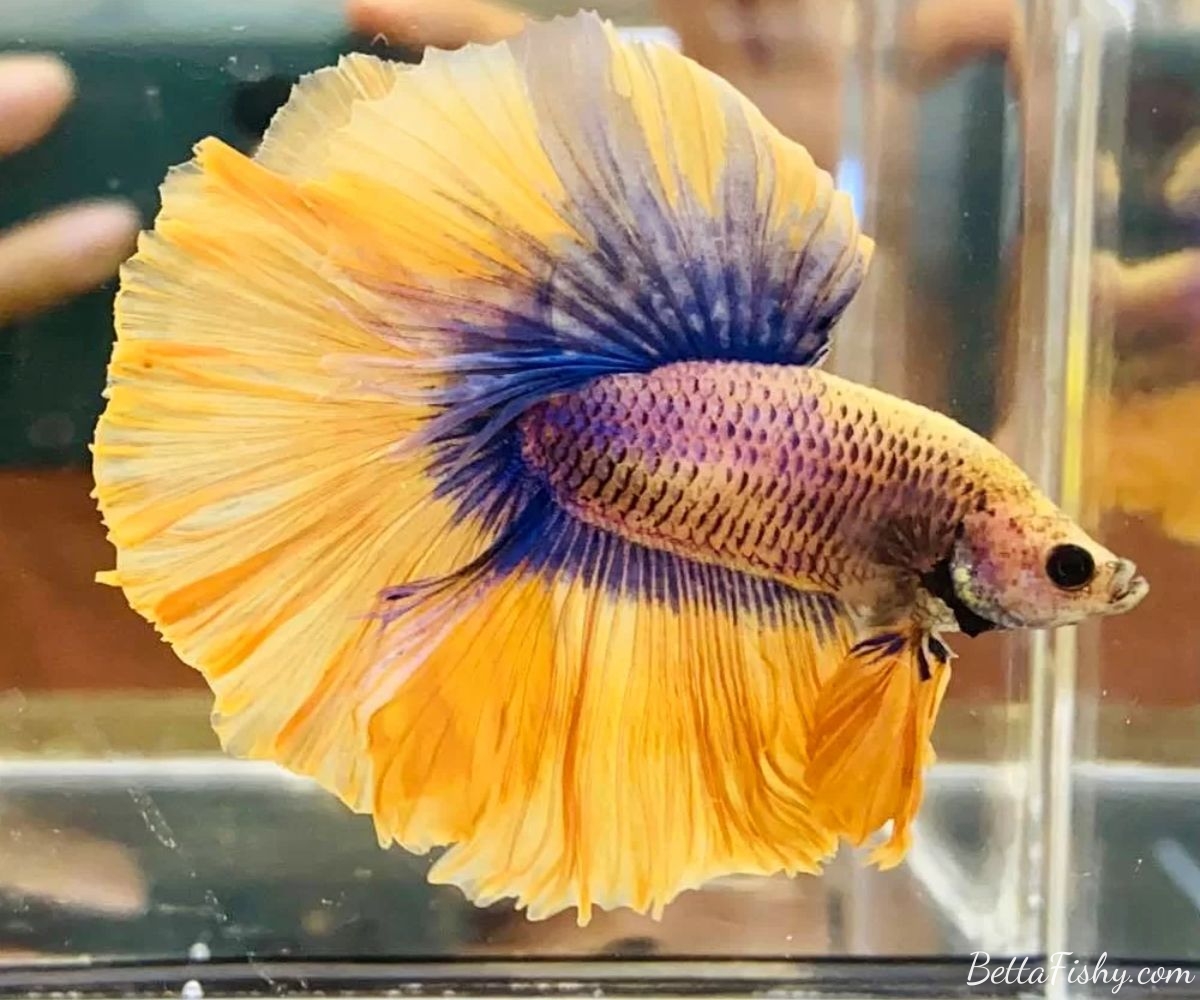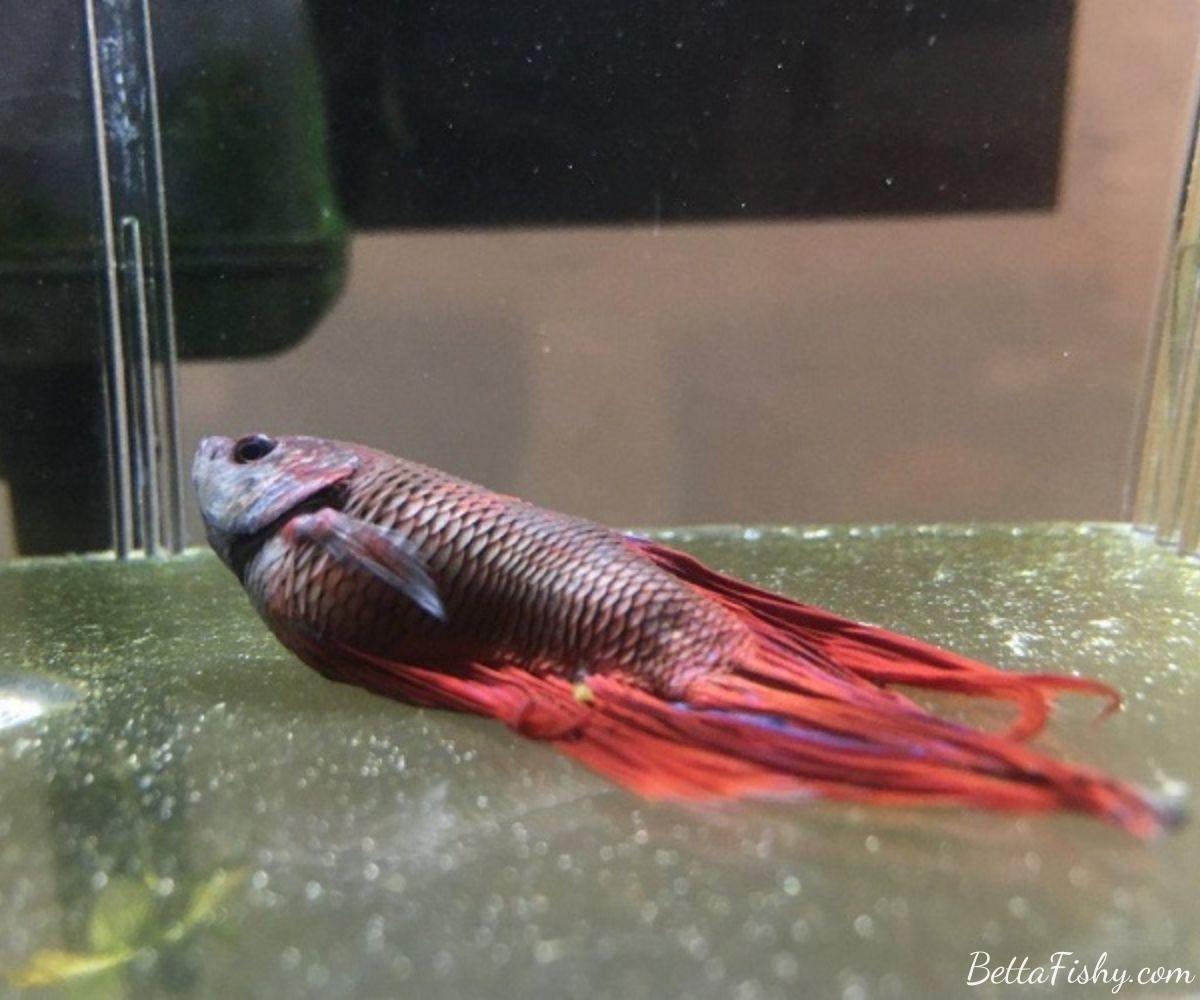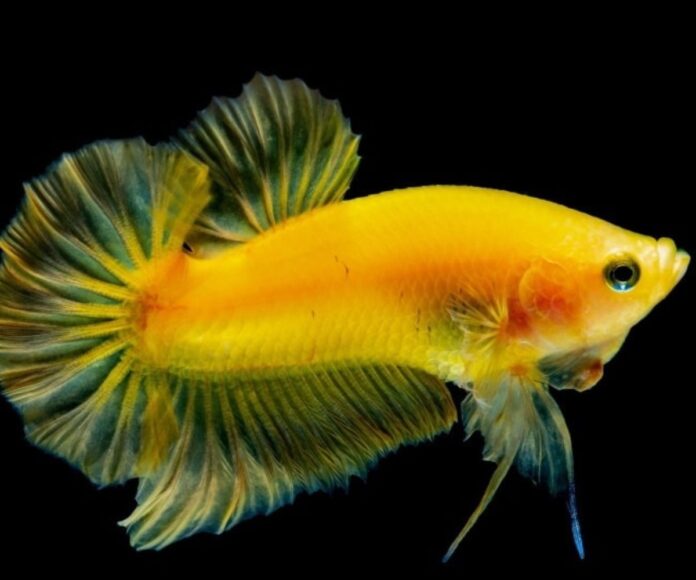Introduction
Betta fish, or Siamese fighting fish, are cherished for their vivid colors and active personalities, tracing back to Southeast Asia’s rice paddies and streams. Gaining worldwide popularity in the 1800s with their flamboyant fins and spirited displays, bettas are now prominent in the aquarium trade. The yellow variety, especially, stands out with its eye-catching hues.
These yellow bettas fish exhibit a spectrum of shades, from pale lemon to deep gold, dazzling under aquarium lights. Although not the rarest, their golden glow makes them a favorite among aquarium enthusiasts, adding a vibrant touch to any tank. In this article, BettaFishy will introduce to you some species, appearance characteristics, and how to raise betta fish from A-Z.
Yellow Betta Varieties

There are many stunning varieties of yellow betta fish. Each has its own unique patterns, scales, and fins that make them stand out. Some of the most popular yellow betta types include:
Solid Yellow
As the name implies, these bettas have a solid bright yellow color covering their body, fins, and head. No other coloring is visible. Their vibrant hue ranges from lemony shades to rich golden tones.
Yellow Butterfly
Butterfly bettas have a light body color with darker hues concentrated around the edges of their fins and tail. Yellow butterfly varieties have bright yellow bodies with black detailing on the tips of their flowing fins.Images of yellow butterfly bettas highlight their graceful appearance.
Yellow Dragonscale
Dragonscale bettas have thick, metallic-looking scales covering their body. Yellow dragonscales showcase this dense scaling in stunning yellow and gold hues. Their scales shine under light.
Yellow Grizzle
Grizzle bettas have a marbled pattern of irregular horizontal stripes across their body and fins. Yellow grizzles feature pale yellow and celadon bands that resemble tiger stripes.
Let me know if you would like me to add any other varieties in this format.
Appearance and Behavior
Yellow bettas stand out thanks to their vibrant, lemon-yellow coloring. Solid yellow bettas will be a consistent vibrant shade all over their body and fins. Other varieties like yellow butterflies may have white or black patterning on their fins, while still featuring a bright yellow base color. Their caudal fins are especially long and flowing. Males in particular flaunt lengthy streamers off their tail and dorsal fins.
Another distinguishing trait is the bubble nests yellow bettas build. Males blow bubbles that collect at the surface of the water, forming a floating nest of bubbles where they later incubate eggs. You may also observe males flaring their gill covers when confronting another betta or a mirror. This aggressive display accentuates the fish’s size and intimidates opponents.
In terms of behavior, yellow bettas tend to be active and aggressive. They may chase other fish that invade their territory and become distressed if housed in cramped quarters. Provide plenty of space and places to hide like plants and caves. Males build more bubble nests when comfortable in their environment.
Males and females exhibit slight differences in appearance. Males possess larger fins and brighter body coloration. Females have shorter fins and paler yellow hues, especially when not breeding. However, both sexes display beautiful shades of yellow.
Lifespan
On average, yellow betta fish have a lifespan of 3-5 years when given proper care. However, some have been known to live even longer when provided with an ideal tank setup.
There are several key factors that impact the longevity of yellow bettas:
- Tank size – Bettas require a minimum 2.5 gallon tank, but the larger the better. Small, cramped tanks reduce lifespan.
- Water quality – Regular water changes, filtration, and testing helps keep water clean. Ammonia and nitrites should be zero.
- Temperature – Water should stay between 75-82°F. Fluctuating temperatures stress fish.
- Diet – A high-quality betta pellet and occasional frozen/live foods is ideal. Poor nutrition hurts health.
- Genetics – Some betta fish are predisposed to live longer than others based on breeding.
- Exercise – Bettas that are active with adequate swimming space tend to live longer.
- Mental stimulation – Providing hides, plants, tankmates boosts wellbeing.
- Preventing disease – Quarantining new fish and acting quickly when ill prevents premature death.
While their lifespan is relatively short compared to some other aquarium fish, following the proper care guidelines can help yellow bettas thrive and achieve their maximum lifespan potential.
Costs of Yellow Betta Fish
Yellow betta fish can vary greatly in price depending on the specific variety and rarity. Most common yellow varieties like solid yellow, yellow butterfly, and yellow grizzle can be purchased for $10 to $30 from local pet stores or online breeders. These varieties are regularly bred and readily available to hobbyists.
Rarer yellow varieties like yellow dragons, yellow samurai, and yellow koi can cost between $30 to $100. These bettas have unique scalation, metallic sheen, or intricate patterns that make them prized by collectors. Importing Yellow bettas from top international breeders in Thailand or Indonesia can also increase costs to $100 or more.
For the most elite specimens like yellow dragonscales with perfect fins or imported show bettas, prices over $200 are not uncommon. Competition-level bettas with outstanding colors and form can even fetch $500+ among dedicated breeders and judges. So while common yellow bettas are affordable pets, truly exceptional fish can be quite an investment.
When sourcing yellow bettas, it’s worth researching breeders and sellers to find high-quality fish at fair prices. With hundreds of color variations, there’s a beautiful yellow betta for nearly every budget.
Ideal Tank Conditions

Yellow bettas require specific tank conditions to thrive. Here are the key factors to provide an ideal environment:
Minimum Tank Size
Yellow bettas should be kept in a tank of at least 2.5 gallons. This provides enough room for them to swim and exercise. A larger 5-10 gallon tank is ideal.
Water Temperature
Yellow bettas do best in water between 78-82°F. Use an adjustable aquarium heater to maintain the temperature.
Filtration
A filter is required to keep the water clean. Get a low-flow filter designed for bettas so there is minimal current in the tank.
pH Level
The ideal pH range is 6.8-7.6. Test the water regularly and adjust as needed.
Hiding Spots
Include plants, rocks, driftwood, or cave decorations so your yellow betta has places to explore and feel secure.
Diet for Golden Bettas
Yellow bettas require a balanced diet to thrive. Their main diet should consist of high-quality commercial foods designed specifically for betta fish. Flake foods, freeze-dried foods, and pellets formulated for betta nutrition are all good options. When feeding flakes or freeze-dried foods, it’s important to soak them in tank water first to prevent bloating.
When it comes to pellets, look for a formula with protein as the first ingredient. Bettas are carnivores and need a diet high in protein to support their health and coloration. Feed just enough pellets that your betta can consume in 2-3 minutes, 1-2 times per day. Overfeeding can lead to swim bladder disorder, constipation, and other issues.
Supplementing their main diet with treats can provide variety. Good options include frozen or live foods like bloodworms, brine shrimp, and daphnia. Offer treats in moderation 1-2 times per week. Avoid overfeeding with rich treats, as this can cause digestive upsets.
With proper, varied nutrition consisting of high-quality commercial foods and occasional treats, yellow bettas can thrive and display their brightest, most vibrant colors.
Common Diseases

Yellow betta fish can be susceptible to some of the same diseases as other betta varieties. Being aware of the common illnesses can help owners identify and treat any health problems early on. Some of the most prevalent diseases in yellow bettas include:
Fin Rot
Fin rot is caused by bacteria or fungi and leads to the fraying and deterioration of the betta’s elaborate fins. It usually results from poor water quality. Symptoms include ragged fin edges, black or red spots near the rotting areas, and fins that appear to be melting away. Treating fin rot involves improving water conditions, using antibiotics, and possibly applying diluted hydrogen peroxide to infected fins.
Velvet
Velvet is a parasitic infection that makes a betta’s skin appear covered in a rusty, goldish dust. The fish will often have clamped fins and scrape against objects in the tank due to irritation. Velvet thrives in poor water quality. It can be treated with medications containing copper, increased water changes, higher heat, aquarium salt, and in severe cases, anti-parasitic medicines.
Ich
Ich (also called white spot disease) is a parasitic problem that causes tiny white dots resembling salt grains to appear all over a betta’s body. In addition to the spots, the fish may have clamped fins, flashing, and increased breathing rate. Improving water quality and slowly raising the temperature can help. Ich medications containing ingredients like malachite green or formaldehyde may also be used for treatment.
Swim Bladder Disorder
Swim bladder issues make it difficult for a betta to swim properly or maintain buoyancy. The fish may sink to the bottom or float helplessly at the surface. This disorder can result from constipation, parasites, infections, or poor water conditions. Treatments include feeding the fish peeled peas, antibiotics, aquarium salt baths, and optimal water maintenance.
Breeding Yellow Bettas
Breeding yellow bettas takes some preparation but can be a rewarding experience. Here are some key steps for successfully spawning yellow bettas:
Conditioning the pair involves feeding them high-protein foods like bloodworms and brine shrimp for 2-4 weeks before breeding. This helps develop brighter coloration and encourages spawning behavior. Make sure the female is nice and plump with a protruding ovipositor.
When ready to breed, introduce the conditioned pair in a separate 10-20 gallon spawning tank. Provide lots of plants and hiding spots. Let the pair interact until they are ready to wrap and spawn. The male will entice the female to lay eggs in his bubble nest.
After spawning concludes, remove the adults as the male may become aggressive. Leave the bubble nest intact with the eggs to hatch in 24-36 hours. Newly hatched fry can survive off their yolk sac for 2-3 days.
Start feeding the free-swimming fry small live foods like infusoria, microworms or vinegar eels 4-6 times per day. Do frequent partial water changes to keep the tank clean. If cared for properly, the fry will mature over 3-4 months.
The yellow coloration is a recessive genetic trait. Breeding a yellow male to a yellow female increases the chances of yellow offspring. Introducing other color genes may produce multicolored fry.
How To Choose a Companion for Yellow Betta Fish
Yellow bettas can be aggressive towards other fish, so it’s important to choose tank mates carefully. Some fish that should be avoided include:
- Other bettas – Male bettas will fight with each other and sometimes even female bettas in close quarters.
- Gouramis – These labyrinth fish are close relatives of bettas and may become territorial.
- Goldfish – Require different water conditions than bettas.
- Mollies – Nippy behavior can stress bettas.
- Angel fish – Can become aggressive, especially as they mature.
However, many potential yellow betta tank mates can coexist peacefully. Some compatible options include:
- Small tetra species like ember tetras or neon tetras
- Rasboras
- Danios
- Corydoras catfish
- Snails
- Shrimp like ghost or cherry shrimp
- African dwarf frogs
The key is choosing tank mates with peaceful temperaments and similar water parameter needs. Having a larger tank of at least 10 gallons provides more room to diffuse aggression. Also, introduce any new tank mates cautiously and be prepared to separate if the betta becomes overly aggressive.
Conclusion
In conclusion, keeping yellow betta fish can be a rewarding and enjoyable experience for both novice and experienced aquarium enthusiasts. By following the tips and guidelines provided in this guide, you can create a vibrant and thriving environment for your yellow betta fish to flourish. From proper tank setup to understanding their unique dietary needs, this article has covered everything you need to know about caring for these stunning fish. Embracing the responsibility of caring for a yellow betta fish not only brings beauty into your life but also fosters a sense of connection with nature. So, if you’re ready to embark on this exciting journey, take the first step towards becoming a responsible and knowledgeable betta fish owner today.


